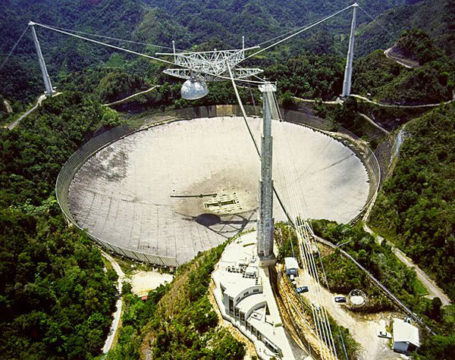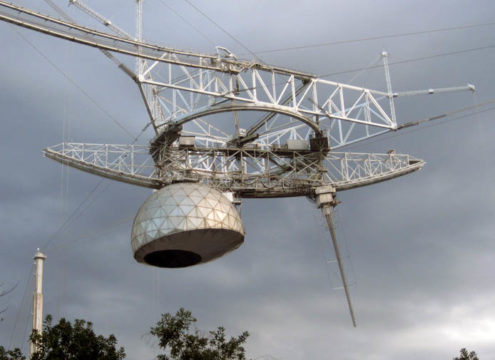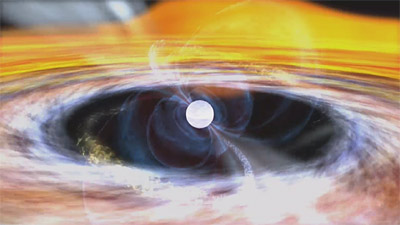The famed Arecibo Observatory has faced down several funding challenges in recent years, and a hurricane to boot, but now a new project is making the radio dish more relevant to astronomy than ever.

NOAO / AURA / NSF / H. Schweiker / WIYN
The famous Arecibo Observatory radio telescope received a recent boost in funding: $5.8 million from the National Science Foundation (NSF) for a key upgrade.
The money will help design and build a super-sensitive set of antennas to be installed at the focal point of Arecibo's dish. The 166 antennas, together part of the phased-array feed to be installed in 2022, are expected to significantly increase Arecibo's capabilities. The phased-array feed will boost the telescope’s sky survey speed, making it five to six times faster than it is now, and it’ll enable the telescope to look at a larger piece of sky at one time.
One major goal for the new instrument is to search for and monitor millisecond pulsars. Astronomers can use minute variations in the pulsations of these spinning stellar corpses to measure the low-frequency hum of gravitational waves suffusing the universe. Though the background lies beyond the reach of LIGO, Arecibo can measure it by monitoring these pulsars as part of the North American Nanohertz Observatory for Gravitational Waves (NANOGrav).

Sky & Telescope / J. Kelly Beatty
This month's announced upgrade comes after years of uncertainty about Arecibo's operations. In September 2017 Hurricane Maria caused about $14 million in damage to the telescope and ancillary buildings, some of which is still being repaired today. The facility lost its 430-megahertz line feed, which was used for atmospheric studies. Pieces of the antenna fell and punctured panels in the primary reflector of the main dish, forcing the replacement of 80–90 of the panels. There was also significant flooding under the primary reflector, which damaged some of the lines and heating facilities. In addition, several pieces of electronic equipment, some imagers, and laser rangers were damaged. Three buildings — a maintenance facility, a heater/transmitter building and a family unit — were also partially or completely destroyed due to rock and tree debris.
The hurricane was only the latest challenge for the observatory, after Arecibo had fought off repeated threats of closure over the previous decade due to NSF funding concerns. The latest situation was resolved last February, when a consortium led by the University of Central Florida took over operation and management of the observatory, significantly lessening the burden on NSF.
Arecibo site director Francisco Cordova says the new funding comes as welcome recognition that 55-year-old Arecibo still has a role to play in today's astronomy. Another signal of its relevance is its role in continued asteroid observations for NASA's Near-Earth Object Observations Program.
"I came here as director about two years ago, and when I first took this job, the facility itself was in a lot of turmoil, and we weren't really sure if NSF would continue to fund Arecibo or not," Cordova recalls. Arecibo was lagging in its maintenance and its own staff did not have much telescope time, he adds. So he reorganized the management structure to increase the share of time available for staff observations, as well as addressing needed maintenance.

NASA
Victoria Kaspi (McGill University) is principal investigator of Pulsar ALFA, which uses the Arecibo L-Band feed array (ALFA) to search for radio pulsars and fast radio bursts in the plane of the Milky Way galaxy. Some of their noteworthy recent results include finding the most highly relativistic binary neutron stars known, as well as one of the few known repeating fast radio burst sources, Kaspi says.
"Even though Arecibo is so incredibly sensitive, its survey potential has been hindered by the fact that it can only see small regions of the sky at any one time," Kaspi says. "Indeed, in our PALFA survey, it has taken many years to cover the galactic plane, simply because each snapshot can see only a tiny portion. With the new phased-array feed, Arecibo will be able to survey much faster because it will see a much larger part of the sky at once."
Arecibo is still renowned for its sensitivity to astronomical radio waves, because its enormous aperture makes it one of the most highly sensitive steerable single-dish radio telescopes on Earth, Kaspi adds. (The only rival to that is the new FAST telescope in China, which is still undergoing commissioning.) She says, however, that Arecibo will need to make sure that radio interference from Earthly sources nearby it remains low, to ensure that Arecibo's new receiver reaches its full potential.
Among the public, Arecibo is perhaps best known for transmitting the 1974 Arecibo Message to communicate with potential extraterrestrial life in Messier 13; that work is just one example of its SETI (Search for Extra-Terrestrial Intelligence) investigations over the years. Arecibo is also famous as a key filming location in the 1995 James Bond movie, "GoldenEye", and the 1997 Hollywood movie "Contact."
 2
2









Comments
Yan-Fernandez
August 27, 2018 at 10:45 am
Just to clarify: the consortium currently managing Arecibo Observatory is led by the University of _Central_ Florida (UCF), not UF.
You must be logged in to post a comment.
Monica Young
August 27, 2018 at 11:33 am
Thank you, I've fixed this typo.
You must be logged in to post a comment.
You must be logged in to post a comment.